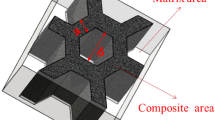Abstract
Using cast tungsten carbide particles (CTCP) and reduced iron powders as raw materials, the porous ceramic preforms with honeycomb, strip, and layer structure, respectively, were prepared by loose sintering process; then, the CTCP/Cr26 ferrous matrix composites were fabricated by casting infiltration process. The microstructure of the composites was analyzed by SEM, XRD, and EDS. The results show that a sintered shell forms as a result of the reaction of Fe and W2C in the CTCP during loose sintering process; the inner part of the shell around the CTCp consists of WC and Fe3W3C phases, while the outer part between the particles is dominated by Fe3W3C. Therefore, the strength of preforms is enhanced because the particles are connected with each other by sintered shell. During casting infiltration process, a transition layer constituted by WC and Fe3W3C formed at the interface of CTCp and the matrix due to the dissolution and precipitation of the sintered shell in the high-temperature liquid iron. The three-body abrasive wear behavior of the composites was investigated. The result shows the wear resistance of honeycomb structure composite is comparable to that of whole layer (WL) structure composite, which is three times of heat-treated Cr26. However, the honeycomb structure composite has higher performance/cost ratio owing to the lower CTCp volume fraction and higher strength and toughness compared with the WL structure composite.



















Similar content being viewed by others
References
Pagounis, E., Lindroos, V.K.: Processing and properties of particulate reinforced steel matrix composites. Mater. Sci. Eng. A 246, 221–234 (1998)
Liu, D., Li, L.Q., Li, F.Q., Chen, Y.B.: WCP/Fe metal matrix composites produced by laser melt injection. Surf. Coat. Technol. 202, 1771–1777 (2008)
Zhou, R., Jiang, Y.H., Lu, D.: The effect of volume fraction of WC particles on erosion resistance of WC reinforced iron matrix surface composites. Wear 255, 134–138 (2003)
Osara, K., Tiainen, T.: Three-body impact wear study on conventional and new P/M + HIPed wear resistant materials. Wear 250, 785–794 (2001)
Li, Y.F., Gao, Y.M., Zhang, J.J., Yan, J.B.: Interface property and two-body wear behavior of high-Cr WCI matrix composite reinforced with CC particles. Key Eng. Mater. 457, 273–278 (2011)
Song, Y.P., Yu, H., He, J.G., Wang, H.G.: Elevated temperature sliding wear behavior of WCp-reinforced ferrous matrix composites. J. Mater. Sci. 43, 7115–7120 (2008)
Kambakas, K., Tsakiropoulos, P.: Solidification of high-Cr white cast iron-WC particle reinforced composites. Mater. Sci. Eng. A 413–414, 538–544 (2005)
Zhang, G.S., Xing, J.D., Gao, Y.M.: Impact wear resistance of WC/Hadfield steel composite and its interfacial characteristics. Wear 260, 728–734 (2006)
Li, Z.L., Jiang, Y.H., Zhou, R., Lu, D.H., Zhou, R.F.: Dry three-body abrasive wear behavior of WC reinforced iron matrix surface composites produced by V-EPC infiltration casting. Wear 262, 649–654 (2007)
Li, Y.F., Gao, Y.M.: Three-body abrasive wear behavior of CC/high-Cr WCI composite and its interfacial characteristics. Wear 268, 511–518 (2010)
Pech-Canul, M.I., Katz, R.N., Makhlouf, M.M.: Optimum conditions for pressureless infiltration of SiCp preforms by aluminum alloys. J. Mater. Process. Technol. 108, 68–77 (2000)
Suetin, D.V., Shein, I.R., Ivanovskii, A.L.: Structural, electronic and magnetic properties of η carbides (Fe3W3C, Fe6W6C, Co3W3C and Co6W6C) from first principles calculations. Phys. B 404, 3544–3549 (2009)
Acknowledgments
This work was supported by the Natural Science Foundation of Shaanxi Province of China (No. 2013JQ6009), the Fundamental Research Funds for the Central Universities of China, the 863 project in China (No. 2013AA031203), the Special Funds for Strategic Emerging Industries Core Technology Research of Guangdong Province in China (No. 2012A090100018), the Scientific Research Program Funded by Shaanxi Provincial Education Department (No. 2013JK0919), and the Research Foundation of Xi’an University of Science and Technology (No.2013QDJ026, 2012QDJ034, 201202).
Author information
Authors and Affiliations
Corresponding author
Rights and permissions
About this article
Cite this article
Zheng, K., Gao, Y., Tang, S. et al. Interface Structure and Wear Behavior of Cr26 Ferrous Matrix Surface Composites Reinforced with CTCP . Tribol Lett 54, 15–23 (2014). https://doi.org/10.1007/s11249-014-0303-6
Received:
Accepted:
Published:
Issue Date:
DOI: https://doi.org/10.1007/s11249-014-0303-6




